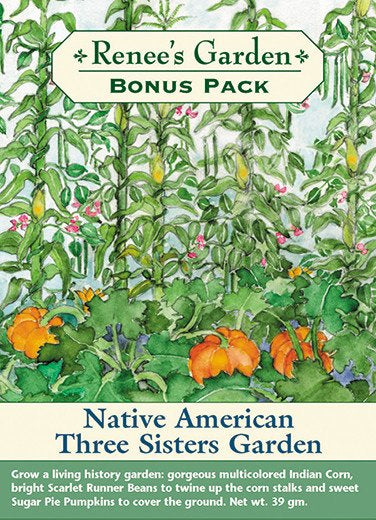
Celebrate the Three Sisters: Corn, Beans and Squash
By Guest Author Alice Formiga
According to Iroquois legend, corn, beans, and squash are three inseparable sisters who only grow and thrive together. This tradition of interplanting corn, beans and squash in the same mounds, widespread among Native American farming societies, is a sophisticated, sustainable system that provided long-term soil fertility and a healthy diet to generations. Growing a Three Sisters garden is a wonderful way to feel more connected to the history of this land, regardless of our ancestry.
Corn, beans and squash were among the first important crops domesticated by ancient Mesoamerican societies. Corn was the primary crop, providing more calories or energy per acre than any other. According to Three Sisters legends corn must grow in community with other crops rather than on its own – it needs the beneficial company and aide of its companions.
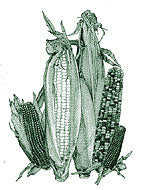 The Iroquois believe corn, beans and squash are precious gifts from the Great Spirit, each watched over by one of three sisters spirits, called the De-o-ha-ko, or Our Sustainers. The planting season is marked by ceremonies to honor them, and a festival commemorates the first harvest of green corn on the cob. By retelling the stories and performing annual rituals, Native Americans passed down the knowledge of growing, using and preserving the Three Sisters through generations. The Iroquois believe corn, beans and squash are precious gifts from the Great Spirit, each watched over by one of three sisters spirits, called the De-o-ha-ko, or Our Sustainers. The planting season is marked by ceremonies to honor them, and a festival commemorates the first harvest of green corn on the cob. By retelling the stories and performing annual rituals, Native Americans passed down the knowledge of growing, using and preserving the Three Sisters through generations.
Corn provides a natural pole for bean vines to climb. Beans fix nitrogen on their roots, improving the overall fertility of the plot by providing nitrogen to the following years corn. Bean vines also help stabilize the corn plants, making them less vulnerable to blowing over in the wind. Shallow-rooted squash vines become a living mulch, shading emerging weeds and preventing soil moisture from evaporating, thereby improving the overall crops chances of survival in dry years. Spiny squash plants also help discourage predators from approaching the corn and beans. The large amount of crop residue from this planting combination can be incorporated back into the soil at the end of the season, to build up the organic matter and improve its structure.
|
Purchase the Three Sisters Garden
Try these great recipes from Renee's cookbooks: 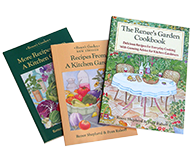
|
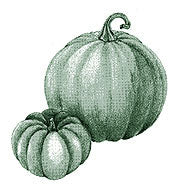
Native Americans kept this system in practice for centuries without the modern conceptual vocabulary we use today, i.e. soil nitrogen, vitamins, etc. They often look for signs in their environment that indicate the right soil temperature and weather for planting corn, i.e. when the Canada geese return or the dogwood leaves reach the size of a squirrels ear. You may wish to record such signs as you observe in your garden and neighborhood so that, depending on how well you judged the timing, you can watch for them again next season!

Early European settlers would certainly never have survived without the gift of the Three Sisters from the Native Americans, the story behind our Thanksgiving celebration. Celebrating the importance of these gifts, not only to the Pilgrims but also to civilizations around the globe that readily adopted these New World crops, adds meaning to modern garden practices Success with a Three Sisters garden involves careful attention to timing, seed spacing, and varieties. In many areas, if you simply plant all three in the same hole at the same time, the result will be a snarl of vines in which the corn gets overwhelmed!
Instructions for Planting Your Own Three Sisters Garden in a 10 x 10 square
When to plant: Sow seeds any time after spring night temperatures are in the 50 degree range, up through June. What to plant: Corn must be planted in several rows rather than one long row to ensure adequate pollination. Choose pole beans or runner beans and a squash or pumpkin variety with trailing vines, rather than a compact bush. At Renee's Garden, we have created our Three Sisters Garden Bonus Pack, which contains three inner packets of multi-colored Indian Corn, Rattlesnake Beans to twine up the corn stalks and Sugar Pie Pumpkins to cover the ground.
Note: A 10 x 10 foot square of space for your Three Sisters garden is the minimum area needed to ensure good corn pollination. If you have a small garden, you can plant fewer mounds, but be aware that you may not get good full corn ears as a result.
How to plant: Please refer to the diagrams below and to individual seed packets for additional growing information.
- Choose a site in full sun (minimum 6-8 hours/day of direct sunlight throughout the growing season). Amend the soil with plenty of compost or aged manure, since corn is a heavy feeder and the nitrogen from your beans will not be available to the corn during the first year. With string, mark off three ten-foot rows, five feet apart.
- In each row, make your corn/bean mounds. The center of each mound should be 5 feet apart from the center of the next. Each mound should be 18 across with flattened tops. The mounds should be staggered in adjacent rows. See Diagram #1
Note: The Iroquois and others planted the three sisters in raised mounds about 4 inches high, in order to improve drainage and soil warmth; to help conserve water, you can make a small crater at the top of your mounds so the water doesn’t drain off the plants quickly. Raised mounds were not built in dry, sandy areas where soil moisture conservation was a priority, for example in parts of the southwest. There, the three sisters were planted in beds with soil raised around the edges, so that water would collect in the beds (See reference 2 below for more information). In other words, adjust the design of your bed according to your climate and soil type.
- Plant 4 corn seeds in each mound in a 6 in square. See Diagram #2
- When the corn is 4 inches tall, its time to plant the beans and squash. First, weed the entire patch. Then plant 4 bean seeds in each corn mound. They should be 3 in apart from the corn plants, completing the square as shown in Diagram #3.
- Build your squash mounds in each row between each corn/bean mound. Make them the same size as the corn/bean mounds. Plant 3 squash seeds, 4 in. apart in a triangle in the middle of each mound as shown in Diagram #4.
- When the squash seedlings emerge, thin them to 2 plants per mound. You may have to weed the area several times until the squash take over and shade new weeds.

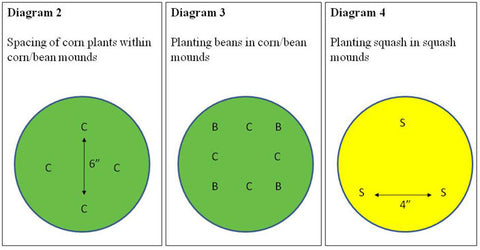
Links to Legends about the Three Sisters:
1. Bird Clan of E. Central Alabama: The Three Sisters http://www.birdclan.org/threesisters.htm
2. Cornell University Garden Based Learning: Three Sisters Garden - A Legend
http://blogs.cornell.edu/garden/get-activities/signature-projects/the-three-sisters-exploring-an-iroquois-garden/a-legend/
3. MN State U: Native American Vegetable Contributions: Three Sisters Garden
http://web.mnstate.edu/tah/lesson-plans/lesson_plans_for_2008-2009/native_american_vegetable_c_2.html
References and Further Reading
- Creasy, Rosalind, "Cooking from the Garden," Sierra Club Books, San Francisco, 1988
- Dodson, Mardi, “An Appendix to Companion Planting: Basic Concepts & Resources - Ancient Companions. ATTRA: National Center for Appropriate Technology, 2002. Available at http://www.attra.org/attra-pub/complant.html#appCultivation.
- Eames-Sheavly, Marcia, "The Three Sisters, Exploring an Iroquois Garden", Cornell Cooperative Extension, Cornell U., 1993
- Hays, Wilma and R. Vernon, "Foods the Indians Gave Us", Ives Washburn, Inc. NY, 1973
Acknowledgement: Thank you to Jane Mt. Pleasant of the Cornell American Indian Program
 The Iroquois believe corn, beans and squash are precious gifts from the Great Spirit, each watched over by one of three sisters spirits, called the De-o-ha-ko, or Our Sustainers. The planting season is marked by ceremonies to honor them, and a festival commemorates the first harvest of green corn on the cob. By retelling the stories and performing annual rituals, Native Americans passed down the knowledge of growing, using and preserving the Three Sisters through generations. The Iroquois believe corn, beans and squash are precious gifts from the Great Spirit, each watched over by one of three sisters spirits, called the De-o-ha-ko, or Our Sustainers. The planting season is marked by ceremonies to honor them, and a festival commemorates the first harvest of green corn on the cob. By retelling the stories and performing annual rituals, Native Americans passed down the knowledge of growing, using and preserving the Three Sisters through generations.
Corn provides a natural pole for bean vines to climb. Beans fix nitrogen on their roots, improving the overall fertility of the plot by providing nitrogen to the following years corn. Bean vines also help stabilize the corn plants, making them less vulnerable to blowing over in the wind. Shallow-rooted squash vines become a living mulch, shading emerging weeds and preventing soil moisture from evaporating, thereby improving the overall crops chances of survival in dry years. Spiny squash plants also help discourage predators from approaching the corn and beans. The large amount of crop residue from this planting combination can be incorporated back into the soil at the end of the season, to build up the organic matter and improve its structure.
|
Purchase the Three Sisters Garden
Try these great recipes from Renee's cookbooks: 
|

Native Americans kept this system in practice for centuries without the modern conceptual vocabulary we use today, i.e. soil nitrogen, vitamins, etc. They often look for signs in their environment that indicate the right soil temperature and weather for planting corn, i.e. when the Canada geese return or the dogwood leaves reach the size of a squirrels ear. You may wish to record such signs as you observe in your garden and neighborhood so that, depending on how well you judged the timing, you can watch for them again next season!

Early European settlers would certainly never have survived without the gift of the Three Sisters from the Native Americans, the story behind our Thanksgiving celebration. Celebrating the importance of these gifts, not only to the Pilgrims but also to civilizations around the globe that readily adopted these New World crops, adds meaning to modern garden practices Success with a Three Sisters garden involves careful attention to timing, seed spacing, and varieties. In many areas, if you simply plant all three in the same hole at the same time, the result will be a snarl of vines in which the corn gets overwhelmed!
Instructions for Planting Your Own Three Sisters Garden in a 10 x 10 square
When to plant: Sow seeds any time after spring night temperatures are in the 50 degree range, up through June. What to plant: Corn must be planted in several rows rather than one long row to ensure adequate pollination. Choose pole beans or runner beans and a squash or pumpkin variety with trailing vines, rather than a compact bush. At Renee's Garden, we have created our Three Sisters Garden Bonus Pack, which contains three inner packets of multi-colored Indian Corn, Rattlesnake Beans to twine up the corn stalks and Sugar Pie Pumpkins to cover the ground.
Note: A 10 x 10 foot square of space for your Three Sisters garden is the minimum area needed to ensure good corn pollination. If you have a small garden, you can plant fewer mounds, but be aware that you may not get good full corn ears as a result.
How to plant: Please refer to the diagrams below and to individual seed packets for additional growing information.
- Choose a site in full sun (minimum 6-8 hours/day of direct sunlight throughout the growing season). Amend the soil with plenty of compost or aged manure, since corn is a heavy feeder and the nitrogen from your beans will not be available to the corn during the first year. With string, mark off three ten-foot rows, five feet apart.
- In each row, make your corn/bean mounds. The center of each mound should be 5 feet apart from the center of the next. Each mound should be 18 across with flattened tops. The mounds should be staggered in adjacent rows. See Diagram #1
Note: The Iroquois and others planted the three sisters in raised mounds about 4 inches high, in order to improve drainage and soil warmth; to help conserve water, you can make a small crater at the top of your mounds so the water doesn’t drain off the plants quickly. Raised mounds were not built in dry, sandy areas where soil moisture conservation was a priority, for example in parts of the southwest. There, the three sisters were planted in beds with soil raised around the edges, so that water would collect in the beds (See reference 2 below for more information). In other words, adjust the design of your bed according to your climate and soil type.
- Plant 4 corn seeds in each mound in a 6 in square. See Diagram #2
- When the corn is 4 inches tall, its time to plant the beans and squash. First, weed the entire patch. Then plant 4 bean seeds in each corn mound. They should be 3 in apart from the corn plants, completing the square as shown in Diagram #3.
- Build your squash mounds in each row between each corn/bean mound. Make them the same size as the corn/bean mounds. Plant 3 squash seeds, 4 in. apart in a triangle in the middle of each mound as shown in Diagram #4.
- When the squash seedlings emerge, thin them to 2 plants per mound. You may have to weed the area several times until the squash take over and shade new weeds.


Links to Legends about the Three Sisters:
1. Bird Clan of E. Central Alabama: The Three Sisters http://www.birdclan.org/threesisters.htm
2. Cornell University Garden Based Learning: Three Sisters Garden - A Legend
http://blogs.cornell.edu/garden/get-activities/signature-projects/the-three-sisters-exploring-an-iroquois-garden/a-legend/
3. MN State U: Native American Vegetable Contributions: Three Sisters Garden
http://web.mnstate.edu/tah/lesson-plans/lesson_plans_for_2008-2009/native_american_vegetable_c_2.html
References and Further Reading
- Creasy, Rosalind, "Cooking from the Garden," Sierra Club Books, San Francisco, 1988
- Dodson, Mardi, “An Appendix to Companion Planting: Basic Concepts & Resources - Ancient Companions. ATTRA: National Center for Appropriate Technology, 2002. Available at http://www.attra.org/attra-pub/complant.html#appCultivation.
- Eames-Sheavly, Marcia, "The Three Sisters, Exploring an Iroquois Garden", Cornell Cooperative Extension, Cornell U., 1993
- Hays, Wilma and R. Vernon, "Foods the Indians Gave Us", Ives Washburn, Inc. NY, 1973
Acknowledgement: Thank you to Jane Mt. Pleasant of the Cornell American Indian Program



